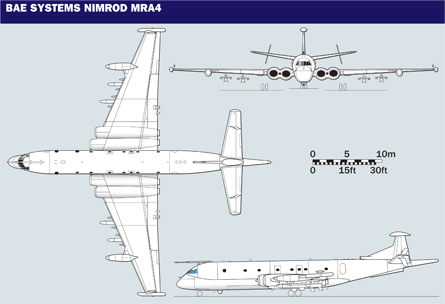The last operational flight of the UK's British Aerospace Nimrod MR2 this week marks the end of a chapter in the Royal Air Force's history, but work on the next instalment is already well under way.
BAE Systems will begin delivering "convex" training for the first four squadron pilots to transition on to the new-generation Nimrod MRA4 at its Warton site in Lancashire around mid-April. The first of nine series production aircraft will then arrive at RAF Kinloss in Scotland around mid-year, with the new type to reach initial operational capability status in October 2012, says station commander Gp Capt Robbie Noel.
 |
|---|
Ready to train: production aircraft PA4 will be used from mid-April to instruct RAF pilots. Photo: BAE Systems |
This timeline reflects a Ministry of Defence decision to impose an 18-month delay on the IOC event, which will be measured by the new fleet's ability to provide 24h cover for an undisclosed number of days. Its action has removed funds intended to span the planned support solution for the aircraft between April 2010 and March 2012.
Another three aircraft are expected to be handed over this calendar year, with the entire fleet to be operational around 2013.
"The MRA4 offers a huge leap forward in terms of its ability to gather, resolve and then deliver information to the commander on the ground, or at sea," Noel says. "It has capabilities apposite in the post-Strategic Defence Review world; not just anti-submarine warfare. One of the absolutely crucial aspects will be its ability to deliver the right information to the right person at the right time."
Wider training activities are already ramping up at Kinloss, including the use of a new Thales cockpit simulator for the aircraft. "The simulator is state of the art, and is already being used in anger very successfully," Noel says. Two rear crew simulators for the MR2 also operated by Thales are being retained in use until March 2011 in support of the new aircraft.
"We brief as if we are going flying, and do full missions of 5h at a time," says RAF simulator manager Flt Lt Neil Mackenzie. "The only thing they don't get is the motion." Squadron personnel currently use the equipment - which replicates the main fuselage of the Nimrod - around once a week to support ASW and anti-surface warfare training, but this rate is on the increase.
"We're going to be a lot busier once the [MR2] aircraft have gone," Mackenzie says. Ground crew for the new aircraft are already working alongside BAE employees.
Eventually, the MRA4 force will comprise 16 10-person crews assigned to 120, 201 and 42(R) squadrons. The legacy posts of air engineering officer and flight engineer have been removed from the new aircraft.
The programme's first production example, PA4, was accepted as ready to support training tasks in mid-March, while the second has already made its flight debut. The remaining aircraft are all now in build, BAE says.
Reusing the fuselage barrel from withdrawn MR2s but otherwise representing an all-new aircraft, the MRA4 will be capable of flying for up to 14h without refuelling.
"The essential national defence task to which those aircraft will be put can certainly be done with nine aircraft," says minister for defence equipment and support Quentin Davies. "With current technology, there is no need for anything like the 21 aircraft that were originally specified."
But Noel cautions: "With nine, there's a limit to what we'll be able to deliver."
 |
|---|
|
|---|
Source: Flight International




















